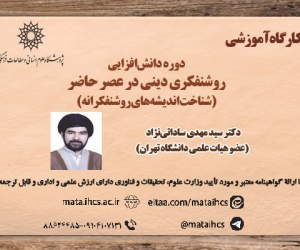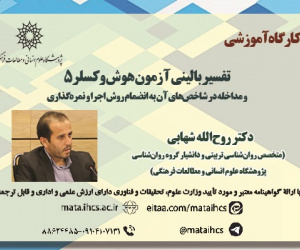کارایی الگوریتم های خوشه بندی فازی در بازشناسی خودکار الگو های مورفولوژیک (مطالعه موردی: رودخانه علاء) (مقاله علمی وزارت علوم)
درجه علمی: نشریه علمی (وزارت علوم)
آرشیو
چکیده
هدف این پژوهش ناحیه بندی فازی با استفاده از تصاویر ماهواره ای GeoEye-1 و الگوریتم های خوشه بندی و ادغام پیشنهادی است و کارایی این تکنیک ها در آشکارسازی عوارض و پدیده های سطح زمین و بازشناسی خودکار الگو های مورفولوژیک در رودخانه علاء بررسی می گردد. در این رابطه پس از پیش پردازش های رادیومتریک و هندسی، بر اساس ویژگی های فازی به ادغام تصاویر ورودی در نرم افزار MATLAB پرداخته و سپس با استفاده از الگوریتم های (FCM)، (PCM)، (GK) و (FSC) به ناحیه بندی مقاوم پوشش زمینی اقدام گردید. در این روش ها خوشه بندی فازی چندین بار و برای تعداد خوشه های مختلف (از c_min تا c_max) انجام گرفته و با ارزیابی خروجی خوشه بندی و انتخاب بهترین تعداد نواحی (c ̂) تعیین شده است. همچنین در مرحله پردازش جهت رسیدن به تعداد مشخصی خوشه، تصویر خوشه بندی می شود تا پس از اعمال Defuzzification بر روی آن، ناحیه بندی فازی صورت گیرد. در نهایت الگوریتم های خوشه بندی فازی مورد بررسی که دارای پارامترهای فازی هستند، بر روی تصاویرHR-PRS ورودی اعمال شده و نتایج آن مورد بحث و بررسی قرار گرفته است. نتایج ناحیه بندی فازی و مقایسه روش های پیشنهادی در محدوده مطالعاتی نشان می دهد که روش Interval-valued Data Fuzzy c-means (FSC) که در آن ابهام موجود در تصاویر HR-PRS در ناحیه بندی لحاظ شده است، در مجموع دارای بهترین عملکرد جهت یافتن تعداد خوشه های بهینه و مراکز خوشه ها و آشکارسازی پدیده های سطحی می باشد. همچنین این الگوریتم قابلیت تفکیک پذیری عوارض را تنظیم و دقت بالاتری را ارائه می دهد و مرزهای اصلی را به خوبی تشخیص و مرزهای اضافی را حذف می کند. این نتایج همچنین نشان دهنده اثربخشی الگوریتم های خوشه بندی فازی جهت ناحیه بندی تصاویر سنجش از دور چند طیفی می باشد و کارایی روش های ناحیه بندی پیشنهادی را از منظر تشخیص عوارض و پدیده های مکانی و استخراج دقیق اطلاعات از تصاویر تایید می نمایند.Efficiency of Fuzzy Clustering Algorithms in Automatic Morphological Pattern Recognition (case study: Alaa River)
IntroductionThe process of changes detection, identifying landforms and how they are distributed is one of the basic needs of geomorphology and natural resources. On the other hand, remote sensing technology is a useful tool for studying and monitoring terrestrial phenomena in order to produce useful and valuable data in terms of spatial and temporal. Therefore, high spatial panchromatic remote sensing (HR-PRS) images are a useful and efficient tool for identifying and classifying landforms due to their high spatial and spectral resolution.Obstacles, such as cloud and shadow coverage, greatly affect the analysis and processing of satellite imagery, such as changes detection, classifying, and extracting accurate information from satellite imagery; Therefore, selecting the most appropriate segmentation algorithms to improve the identification and detection of landforms in these areas is of great importance. The selection and development of these algorithms, under the influence of parameters such as radiometric accuracy, atmospheric conditions, spectral, spatial, thematic and temporal resolution, provide a powerful technology for extracting information and preparing thematic maps that can be monitored and evaluated. Provides better landforms and environmental change trends by comparing temporal images. In this regard, fuzzy clustering algorithms is one of the methods that has acceptable performance in the segmentation of high spatial resolution (HR-PRS) images. The aim of this study is fuzzy segmentation using GeoEye-1 satellite imagery and proposed clustering and fusion algorithms, and the effectiveness of these techniques in anomaly detection, landforms and automatic formic patterns recognition are examined in the study area. Therefore, in this paper, a study of fuzzy zoning techniques of high spatial resolution (HR-PRS) images in order to better and more accurately detect geomorphic features in areas with obstacles of interpretation and analysis, including Cloud and shadow cover can be useful for planning, management and future sustainable development of areas. MethodologyIn this paper, fuzzy segmentation process and clustering algorithms are used with the aim of anomaly detecting and automatic morphic pattern recognition. For image segmentation, in addition to radiometric features, the spatial information of HR-PRS panchromatic images extracted by tissue features is also used. In addition, fuzzy clustering numbers and methods are used to improve the accuracy of study area segmentation. The study area in this study is located on Alaa River in Ramhormoz. In this regard, the panchromatic images of HR-PRS GeoEye-1 sensor have been used. In this regard, after radiometric and geometric preprocessing, based on fuzzy features, the input images were integrated in MATLAB software and then using FWS, MSA, IDF and CFM algorithms, segmentation was performed. In these methods, fuzzy clustering is performed several times for different numbers of clusters (from to ) and the clustering output is evaluated and the best number of regions ( ) is selected. Also, in the processing stage, in order to reach a certain number of clusters, the image is clustered so that after defuzzification is applied on it, fuzzy segmentation is performed. Finally, the studied fuzzy clustering algorithms with fuzzy parameters are applied to the input HR-PRS images and the results are discussed. Results and DiscussionIn order to compare and analyze the performance of fuzzy clustering in the segmentation process, FWS, MSA, IDF and CFM algorithms were applied and processed on HR-PRS panchromatic images of the study area. The results of fuzzy segmentation and comparison of the proposed methods in the study area (Figure 4) show that the Interval-valued Data Fuzzy c-means (IDF) method has a better performance for fuzzy segmentation than other methods. The IDF method, in which the ambiguity in the HR-PRS images in the segmentation area is taken into account, has the best performance in general to find the optimal number of clusters and centers of clusters and to detect features. This algorithm also adjusts the detection capability and provides higher accuracy and detects the main boundaries well and removes the extra boundaries. The results also show that the Fuzzy Watershed Segmentation (FWS) method in the field of spatial features detection and river detection, which is a spatial criterion, has shown good performance in fuzzy clustering and in pixel fuzzy clustering. HR-PRS images examined image boundaries are well separated. However, due to its high sensitivity to noise, the FWS method faces the problem of creating additional boundaries. As a result, it has not well identified the main boundaries in the shadow and cloud cover area. ConclusionThe results of applying the studied fuzzy segmentation algorithms on the study area show the use of local and global spatial relationships of pixels for fuzzy clustering of HR-PRS images and also the use of textural, structural and spectral features for segmentation and object recognition in panchromatic images have a high ability to detect geomorphic features. These results also indicate the effectiveness of fuzzy clustering algorithms for segmentation multispectral remote sensing images and confirm the efficiency of the proposed segmentation methods in terms of detecting spatial features and phenomena and accurate extraction of information from images.







